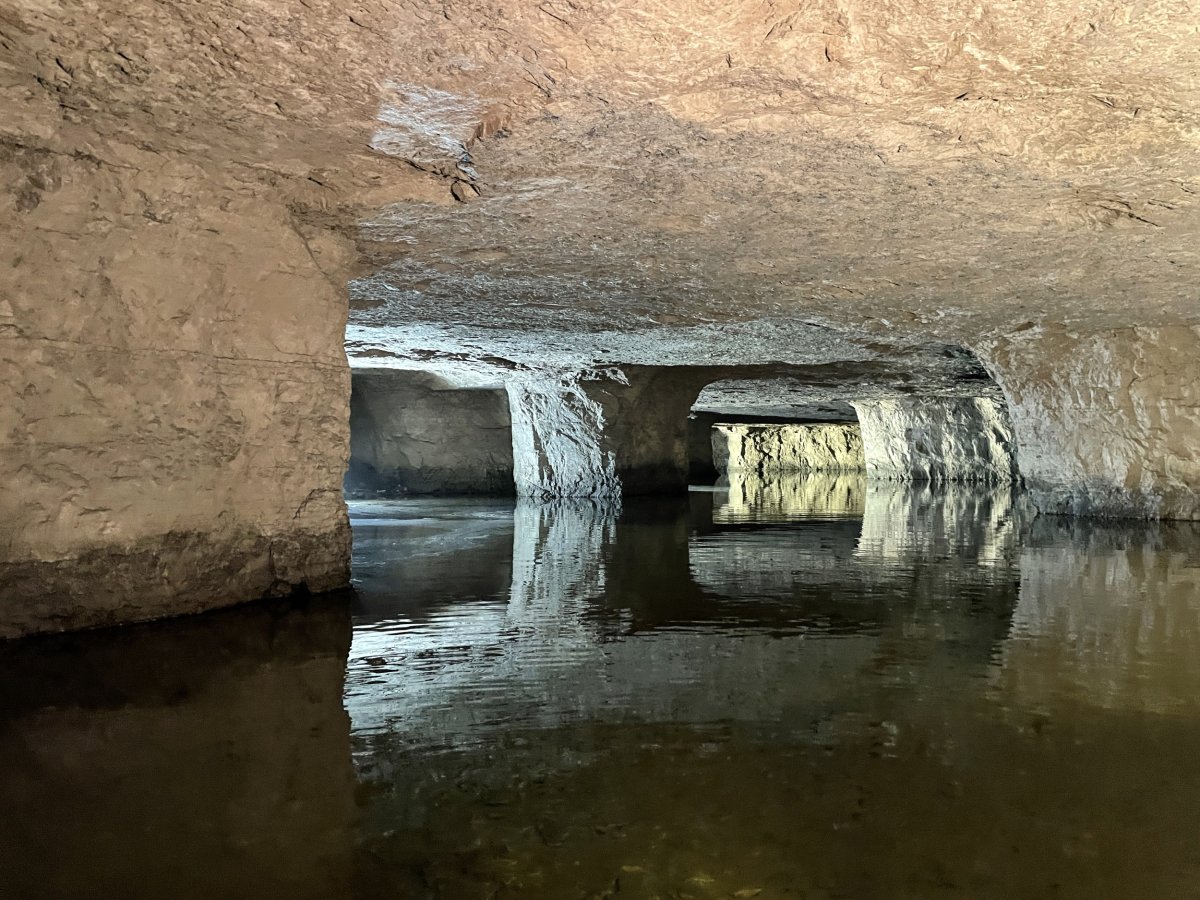With its affordable land and modest electricity rates, Iowa has become a magnet for data centers for some of the world’s tech giants.
Tech companies also like Iowa’s wind power, which gives it the country’s highest rate of renewable energy. Some 60 percent of Iowa’s electricity comes from renewable sources, so tech companies can power their data centers there while also working toward ambitious climate goals for low-carbon power.
While Iowa is rich with green energy, there’s another crucial resource that data centers need but Iowa often lacks: water.
As data center operators power up the servers that keep the internet humming and make artificial intelligence possible, they also need large volumes of water to cool those servers down, to keep them from overheating. The growing water consumption by data centers is becoming a challenge for some host communities.
“There’s definitely parts of Iowa that are starting to feel the squeeze on water,” Iowa Environmental Council Energy Program Director Kerri Johannsen told Newsweek.
Justin Sullivan/Getty Images
Johannsen’s group is tracking the increasing water usage by the state’s data centers, most of them clustered in suburbs around Des Moines.
“There’s a data center in a suburb called Altoona where they’re using up to about one-fifth of the water that the city is using, and that’s really significant,” she said.
Iowa is in the midst of one of its most prolonged droughts in decades. The National Oceanic and Atmospheric Administration reported that by mid-March about 85 percent of the state was in drought condition, and about 56 percent of the state was in extreme or severe drought.
State Geologist Keith Schilling warned earlier this year that groundwater levels are declining in some of the state’s aquifers and that the state “needs a plan to safeguard groundwater reserves.” Along with the traditional water uses the state must balance, such as agriculture and residential systems, Schilling also listed “data centers requiring vast quantities of cooling water.”
The boom in AI is adding to the water demand. Recent research shows that the enormous computing power, larger chips and additional servers required for AI not only add significantly to electricity demands, but also make many of those data centers much thirstier.
AI is likely already driving an increase in water use by some tech companies, researchers say, and their projections for the coming years show global AI growth could require more water than some small nations consume.
As many major tech companies position themselves to rapidly scale up operations to support AI, they must also reckon with their growing water demand. And some data center host communities in water-scarce regions could face difficult choices amid a dearth of solid information about how much water they might be giving up.

Bill Clark/Getty Images
What Makes AI So Thirsty?
Shaolei Ren, an associate professor in the Electrical & Computer Engineering Department at the University of California, Riverside, has been researching big tech’s water use for about a decade.
“People were talking about carbon emissions when they study sustainable computing, but I believe that water is also a very important metric,” Ren told Newsweek.
Ren’s most recent work focuses precisely on how AI is increasing water use. A large language model like OpenAI’s popular ChatGPT-3 must first be trained, a data and energy intensive process that can also boost water use. Ren found that training GPT-3 in Microsoft’s high-end data centers can directly evaporate 700,000 liters, or about 185,000 gallons, of water.
Once the AI model is in use, each inference, or response to queries, also requires energy and cooling, and that, too, is thirsty work. Ren and his colleagues estimate that GPT-3 needs to “drink” a 16-ounce bottle of water for roughly every 10-50 responses it makes, and when the model is fielding billions of queries, that adds up.
To get the full measure of water use, Ren looked at both the water directly used in cooling servers in a data center and the water used in the generation of electricity the data centers require.
“When we generate electricity using coal-based power plants, using nuclear power plants, we are actually also consuming a lot of water,” he explained, and AI is sharply boosting the energy that data centers need.
Add all that water up and apply it to the projected growth in AI in the next few years and the total quickly reaches a staggering level. Ren concluded that global AI demand could result in as much as 6.6 billion cubic meters, or 8.6 billion cubic yards, of water withdrawal by 2027. To put that in perspective, he compared it to how much water some countries use.
“This will be roughly equivalent to four to six Denmarks of national water withdrawal,” Ren said. “That’s quite a lot.”

Courtesy of Iron Mountain
Microsoft’s AI Training
Ren said Microsoft’s total water use grew by 34 percent in 2022, the most recent year for which data is available, and that increase is likely due at least in part to AI’s demands. That has major implications for places like Iowa where Microsoft has used its data centers to train OpenAI models and where water use is becoming a concern.
Microsoft opened its first Iowa data center in West Des Moines in 2012 and had built four more in the area by the end of 2023. Those facilities include the Azure supercomputer Microsoft built for OpenAI to train its AI models, making “a small city in America’s heartland an unlikely epicenter for the AI revolution,” the company wrote in a press release last year.
A Microsoft spokesperson declined to comment on Ren’s calculations about its water use but pointed out that the company has set a goal to become “water positive” by 2030, meaning it will return more water to the environment than it uses. Microsoft said it has also met an interim goal to reduce water waste by 95 percent.
Microsoft ranks 34th on Newsweek‘s 2024 list of America’s Most Responsible Companies, and fifth among companies in software and communications.
Microsoft’s Vice President of Energy Bobby Hollis said energy and water needs are closely intertwined and must be considered together to optimize a data center’s sustainability performance.
“You’ve got sort of the yin and the Yang, the counterbalance of the two, figuring out which one you’re going to focus more of your effort on,” Hollis told Newsweek.
Where clean energy is abundant and water is scarce, he said, the company uses more air-cooling methods to reduce water impacts, and closed-loop systems prevent loss due to evaporation.
“And it depends, of course, on geography and what you’re looking at for that location: how dry the place is, how cool it is,” Hollis said.
Iron Mountain’s Deep Thinking
At a data center just north of Pittsburgh in Boyers, Pennsylvania, the company Iron Mountain dug deep for sustainability solutions—literally. The company’s facility there is more than 200 feet underground in a former limestone quarry that keeps servers naturally cool and offers a water source that doesn’t draw from the neighboring community’s system.
“We utilize a large underground lake to cool the data center, and regularly monitor the water level and temperature of the lake,” Iron Mountain Director of Energy & Sustainability Chris Pennington told Newsweek in an email exchange. “It works extremely well and is a feature that helped the site become the first underground facility to receive Energy Star certification.”
(The U.S. Environmental Protection Agency’s Energy Star certification recognizes facilities that meet its criteria for energy efficiency.)

Courtesy of Iron Mountain
A pump lifts the water from the lake to a heat exchanger where the cool water carries heat away from the closed-loop cooling system that circulates among the servers. That water is then returned to the lake. Being underground also makes the site highly secure, a selling point for some Iron Mountain clients who handle sensitive data.
Innovations like that helped Iron Mountain earn four stars on Newsweek‘s 2024 ranking of America’s Greenest Companies.
“Not every data center can be underground with its own lake, however,” Pennington said, and the main takeaway from Iron Mountain’s underground example may be this: Think deeply about local characteristics when building data centers.
Equinix is one of the world’s biggest data infrastructure providers and occupies slot No. 181 among the 600 companies on Newsweek‘s ranking of America’s Most Responsible Companies.
When Equinix Vice President of Global Sustainability Christopher Wellise spoke to Newsweek, he happened to be in northern Europe, and he offered some regional examples of how the company is cleverly adapting its data center operations to local conditions and needs.
“Here in the Nordics, we can use lots of free air cooling,” Wellise said. “But then you’ve potentially got some valuable heat that can be used for other purposes.”
In most U.S. settings, unfortunately, there’s no easy way to put that heat to use. But in European cities with district heating systems, Wellise said, the “waste” heat from data servers can be sent through a central network of pipes and ducts to heat homes and buildings.

Bertrand Guay/AFP via Getty Images
“In Helsinki, we heat thousands of homes,” he said. “You have to think about these things in terms of full life-cycle management, not just the electrons that you’re using and how green or brown are they.”
That holistic thinking will have a highlight moment in July when athletes gather in Paris for the Summer Olympics. The new Olympic aquatic center’s pool will be connected to an Equinix data center, and diving and swimming competitors will be kept comfortable using the excess heat produced by the data servers. It’s an intriguing example of the possibilities available to us in this new AI age.


